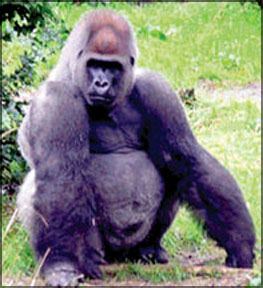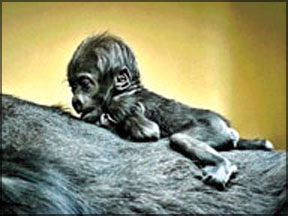|
Nature Trail
Gorillas:
Critically endangered
The largest and most powerful of the primate species in the wild, the
gorillas are our closest relatives.
But, we humans have not treated our ‘wild’ relations in a proper
manner; we’ve not only destroyed their habitats for our own benefits,
but also hunted them down and killed them for their flesh, skin and for
various other purposes.
 In fact, one of the Western gorilla (Gorilla, gorilla) subspecies,
the Western lowland gorilla (Gorilla, gorilla, gorilla ) is listed as
critically endangered at present. It is the highest threat category
given for any species of animal. In fact, one of the Western gorilla (Gorilla, gorilla) subspecies,
the Western lowland gorilla (Gorilla, gorilla, gorilla ) is listed as
critically endangered at present. It is the highest threat category
given for any species of animal.
According to researchers, a 1980s survey by Wildlife Conservation
Society (WCS) had revealed that there were only 100,000 gorillas
belonging to this subspecies of the Western gorilla left worldwide.
These numbers were believed to have halved since then and the
possibility of this subspecies disappearing completely from our planet
was growing stronger by the day. But, guess what? A great discovery was
made recently. Scientists came across a large troop of western lowland
gorillas living in a swamp in Equatorial Africa! Isn’t that really
exciting news?
When these scientists and researchers were informed about the
existence of a large group of primates in northern Congo, they had gone
there to verify it. In fact, they had trekked about 80 km (50 miles)
into the jungle from near the road in the outskirts of Lac Tele to get
to the swamp where the gorillas had been spotted.
And it had proved to be a rewarding trek with the discovery of not
just a couple of hundred of gorillas, but around 125,000 of them. Just
imagine how wonderful it is to discover an entire colony of gorillas at
a time when this species is under severe threat of extinction?
Now, just in case you are wondering if the expedition team managed to
take a census of these creatures to come up with this large number, the
answer is no. They had come to this conclusion going by the number of
nests gorillas make out of leaves and branches of trees etc to sleep in.
This is indeed a great discovery for humanity, but what impact would
it have on the primates who have succeeded to thrive on their own,
undisturbed by humans and free from any threats all this time?
Would they be safe from human predators now that they have been
discovered, is questionable. Let’s hope they would be highly protected
and the entire territory they presently live in is declared a sanctuary
and restricted zone, as proposed by the researchers.
Meanwhile, let’s step into the jungle to check out how our closest
relatives live on the ‘wild side’ of life...
The western lowland gorilla which is a subspecies of the western
gorilla is found in montane, primary and secondary forests and lowland
swamps. The countries they inhabit include Angola, Cameroon, the Central
African Republic, Congo, the Democratic Republic of Congo, Equatorial
Guinea and Gabon.
But, you need not travel all this way to see them up close. All you
have to do is make a trip to the zoo. Most zoos around the world have
these gorillas on display; sometimes in environments closely resembling
their natural habitats, but most often in iron cages with restricted
floor area for these large creatures to move about.
 These gorillas, like most of the other primates, live in large groups
as they are social creatures. However, the western lowland gorillas have
the smallest family groups of all gorillas, sometimes numbering about 30
individuals. Their family groups tend to be smaller then that of their
mountain cousins. These gorillas, like most of the other primates, live in large groups
as they are social creatures. However, the western lowland gorillas have
the smallest family groups of all gorillas, sometimes numbering about 30
individuals. Their family groups tend to be smaller then that of their
mountain cousins.
These highly structured family groups are led by an old, dominant
male gorilla known as the silverback due to the patch of silver hair on
its back. It is the silverback who regulates what time the family group
wakes up, eats, plays and goes to sleep.
The family group consists of the silverback 5-6 females, newborns and
adolescents and possibly a few non-dominant males.
The gorillas are very active during the mornings. They wake up after
sunrise to search for food and once they find food, spend long hours
filling their stomachs. As gorillas are predominantly folivorus (leaf
eating) they primarily feed on leaves and stems, rather than fruits. A
silverback eats upto 6.5 lbs of vegetation per day. Apart from leaves
and plants including bamboo, it occasionally eats insects.
During midday, they take a break and usually the adults take a nap
while the young spend the time wrestling and playing.
Researchers who have observed their activity claim that the gorilla
offspring closely resemble little children at play. Their games are said
to be in line with ‘Follow the leader’ and many such games children
generally play.
Once the adults wake up after their midday nap, it’s time once again
to eat. However, meal time comes to a close before dusk falls. Then,
each gorilla makes a nest to sleep in the night, until daybreak. Then
the routine starts all over again.
The silverback is protective of its group, but does not defend its
home territory. Even though such groups’ territories overlap sometimes,
the gorillas try to steer clear of others’ home territories. So, they
hardly have territorial disputes, but when the silverback needs to
protect its family, it could turn aggressive - at least in appearance.
When threatened or provoked, the adult male stands on its legs and
puts on an elaborate display of aggression. It starts slapping its broad
chest with cupped hands, roaring and screaming all the time.
If you encounter a gorilla in this mood you are sure to fall down in
a dead faint, or turn back and run as fast as your legs would carry you,
screaming for dear life.
But, you will be amazed to learn that for all its show of strength
and power, the huge gorilla is characterised as a quiet, peaceful and
very non-aggressive animal. It never attacks unless provoked.
Even when confronting another gorilla or an enemy, it first tries to
intimidate the opponent with its aggressive display first and if it
fails, then resorts to another tactic; rear its head, drop on all fours
and charge.
Even in this instance, it does not charge at the opponent, but merely
passes by without really hitting the target - as indicated.
Many of you must able to describe how a gorilla looks. It is usually
a very big-made creature which is frightful in appearance. A fully grown
male is about 6 feet (1.8m) tall when it stands on its hind legs.
It usually weighs about 450 pounds (200 kg). It’s stocky in
appearance with a broad chest, muscular neck, strong hands and feet,
short muzzle, small, human-like eyes and ears and flared nostrils.
The gorilla has a thick ridge of bone that juts out above the eyes,
giving it a very nasty look. Its body is covered with a short, thin
grey-black to brown coat of hair except on the face, ears, hands and
feet.
 The hair on the ridge above the eyes is sometimes reddish brown in
colour. Proportionately it has large hands with nails on all digits and
very large thumbs. Its teeth are broad and strong and jaw muscles are
large. The hair on the ridge above the eyes is sometimes reddish brown in
colour. Proportionately it has large hands with nails on all digits and
very large thumbs. Its teeth are broad and strong and jaw muscles are
large.
One of the reasons researchers are highly worried about the depleting
numbers is their reproductive cycle. A female gorilla which does not
reach maturity to reproduce until about 9-10 years produces only one
offspring once every 5-6 years after a gestation period of 9 months.
Generally only the dominant male or silverback fathers offspring in
the group. The babies are born helpless like human babies and weigh
about 3-5 lbs. But, they grow at twice the rate of human babies.
The babies are carried by their mums until they are three months old
by which time they are able to crawl and ride on the backs of their
mums. Very often the male gorilla is seen baby-sitting while the females
forage for food. The offspring are nursed by their mothers until they
are about 3-4 years old.
Well, now you can understand how important these human-like large
primates are and make a firm commitment to protect them in whatever
small way you can.
As a first step in this direction, you could learn as much as
possible about these gorillas and educate others about them.
Creating an awareness is crucial when it comes to protecting other
animal species, especially these that are threatened with extinction
today. With global warming, the list of endangered species is growing,
so get into action now.
Fact file
| The Western gorilla has two recognised subspecies; the Western
lowland gorillas and the cross river gorillas.
The Eastern gorilla also has two recognised subspecies - namely the
mountain gorillas and eastern lowland gorillas. The proposed third
subspecies is the Bwindi population of gorillas. All these subspecies
are threatened by extinction.
Only about 250-300 cross river gorillas are believed to exist in the
highlands of Cameroon and Nigeria.
Hunting (for bushmeat), habitat loss and Ebola (a kind of fever with
bleeding involved) are the main causes leading to the decreasing numbers
of gorillas worldwide.
More than 70 per cent of monkeys, apes and other primates are
classified as vulnerable, endangered or critically endangered today.
The gorilla is a very intelligent animal and has even mastered sign
language in captivity to communicate with humans.
Even though gorillas eat mostly leaves and stems in the wild, in
captivity they prefer to eat baked sweet potatoes or yams, baked
bananas, raw fruits, milk, eggs, dry cereal and raisins.
Gorillas can climb trees, but they prefer to stay on the ground
foraging for food and socialising.
On average, females are only 1.25 mts tall.
Western gorilla species are slightly more brown or grey with shorter
hair than the other two species.
Humans and leopards are the primary predators of gorillas. |
|
